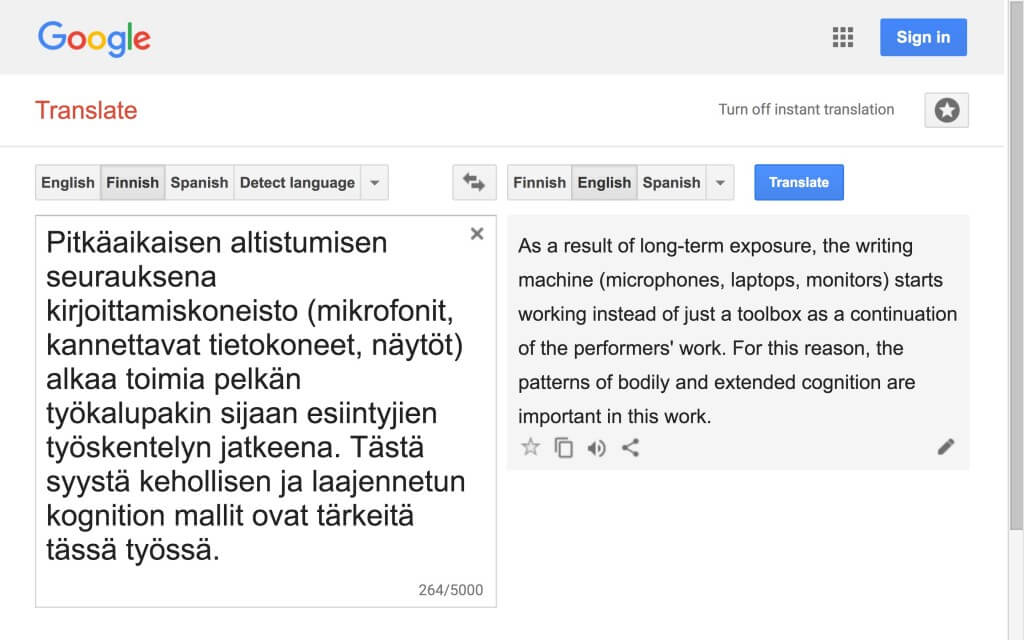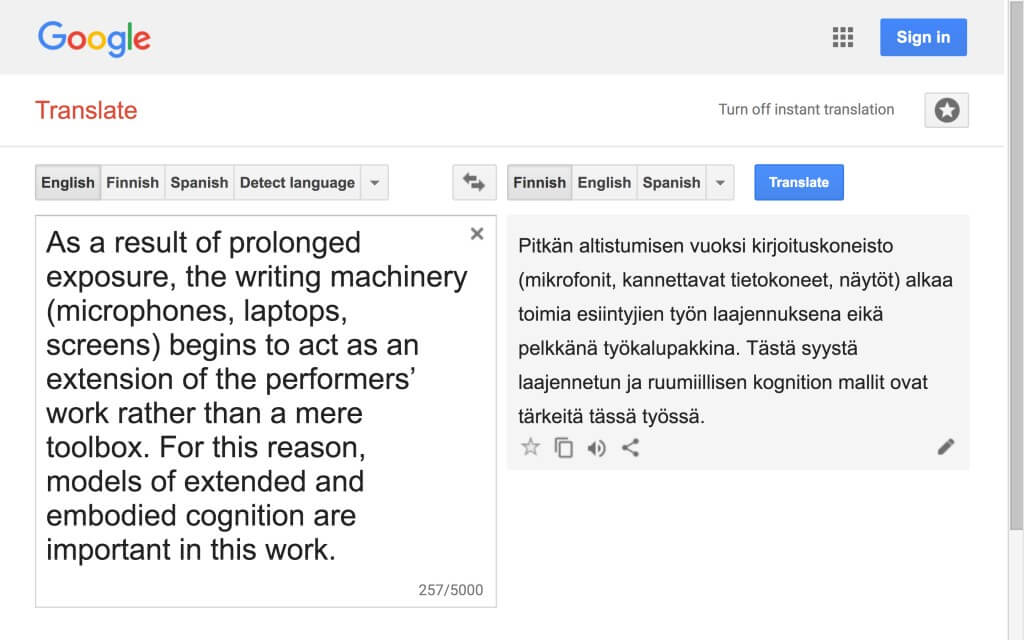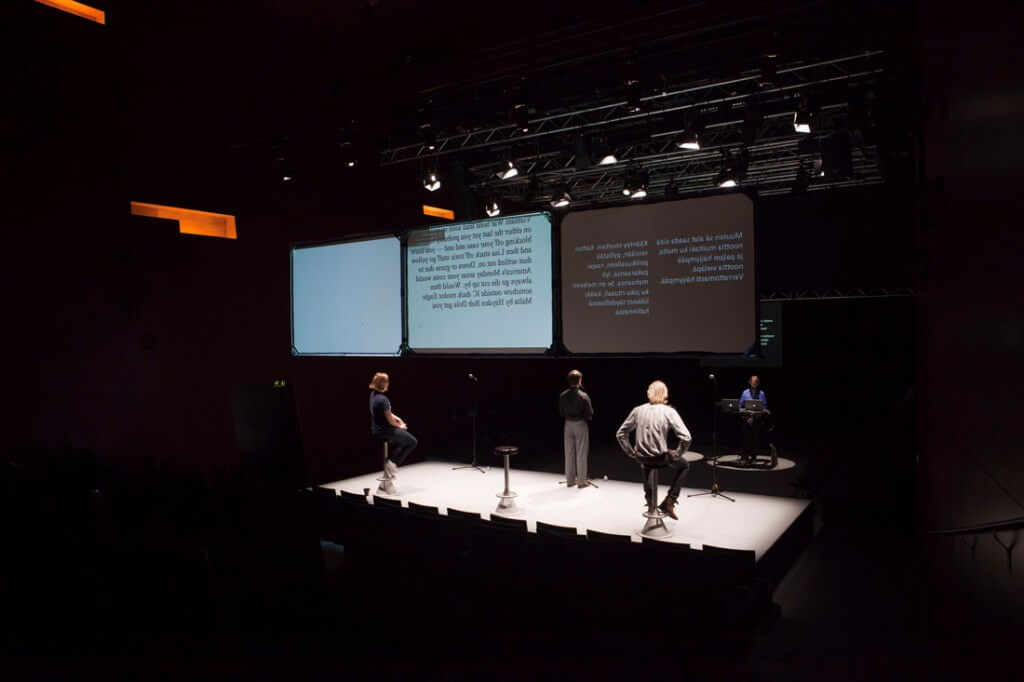2.8 Fragmentti 20
- Fragmentti 20, sovitettu Hayles-katkelmasta 16
Fragmentti 20:n yhteydessä voisin kysyä, eikö DAR ole hieman liian nopea ja suoraviivainen seuratessaan Haylesia kehollisen ja laajennetun kognition suuntaan, nämä verrattain uudet kognition mallit kun ovat yhä kiistanalaisia ja kehittyviä (2.8FI1). Lisäksi voisin love.abz/(love.abz)3:n tuntemuksellani kyseenalaistaa DAR:n käsityksen, että esitykset kokonaisuudessaan ja niissä harjoitetut lukemis- ja kirjoitusmetodit erityisesti antavat aihetta kiinnittyä näihin kognition systeemisiin malleihin. Niin ikään voisin esittää, ettei DAR tunne kyseisiä malleja riittävän hyvin soveltaakseen niitä love.abz/(love.abz)3:een tai koetellakseen teorioita esityksistä käsin.
Symptomaattisen luennan sijaan vastauksena fragmentti 20:een esitän kuitenkin pinta- tai interrogatiivisen luennan (ks. 1.12). Aluksi tämä merkitsee sitä, että otan fragmentin sellaisenaan vastaan kyseenalaistamatta välittömästi sen väittämiä. Assosiatiivisessa luennassani viittaan toiseen Hayles-katkelmaan (en siis siihen, jota fragmentti 20 sovittaa), jossa hän käsittelee kehollista ja laajentunutta kognitiota keramiikkaharrastuksensa kautta (2.8FI1.5). Käyttämällä katkelmaa lähtökohtanani tunnustelen, miltä osin kehollisen kognition käsite resonoi tämän tutkimuksen kanssa. Vastineeni jälkimmäisessä osassa käsittelen laajentunutta kognitiota samalla tavalla.
Kehollinen kognitio
Hayles kuvaa ruukun valmistamisen prosessia dynaamiseksi, monitahoiseksi vuorovaikutukseksi sekä materiaalin (saven) että työkalun (vääntöpyörän) kanssa. Kehon kautta omaksutulla tiedolla on prosessin kulun ja lopputuloksen kannalta ratkaiseva merkitys. Rinnastaessani savenvalannan ja love.abz/(love.abz)3:ssa harjoitetun esityksellisen kirjoittamisen lähden Haylesin tavoin siitä, että kehon kautta omaksutulla tiedolla on merkittävä rooli molemmissa prosesseissa. Savenvalannassa kognitio ulottuu vääntöpyörään valajan ”rytmisen potkimisen kautta”, kun taas esityksellisessä kirjoittamisessa vastaavanlainen ulottaminen tapahtuu äänen kautta: kirjoittaja-esiintyjän puhuessa mikrofoniin kognitio jatkuu kirjoittamiskoneistoon. Hayles kuvaa sitä, miten hän lähtee liikkeelle ruukkua koskevalla tietoisella idealla samoin kuin kirjoittaja-esiintyjä tavoittelee improvisaatiossa tietynlaista repliikkiä tai lausetta – tai jopa suurempaa kokonaisuutta (esimerkiksi juonta). (Hayles 2012, 92.)
Työstäessään savea, alustaessaan sitä Hayles kertoo saavansa käsiensä kautta monenlaista tietoa sen koostumuksesta. Savi ja digitaalisen kirjoittamiskoneiston puitteissa syntyvä tekstimassa ovat materiaaleina hyvin erilaisia. Siitä huolimatta on selvää, että myös kirjoittaja-esiintyjä omaksuu monenlaista tietoa materiaalistaan katsoessaan valkokankaalle ilmestyvää tekstiä. Tekstin lisäksi hän näkee (sivusilmin tai kääntyessään, ks. kuva 2.8.1) muut esiintyjät ja ainakin osan yleisöstä. Hän aistii tilassa tapahtuvan liikehdinnän. Hän kuulee paitsi muiden esiintyjien myös yleisön äänet, kirjoittamisprosessin kirvoittamat reaktiot. Järjestelmän toimivuudesta hän saa tietoa muun muassa kursorin liikehdinnästä näytöllä (2.8FI2).
Kokonaisuudessaan tämä kehollinen tieto epäilemättä vaikuttaa siihen, miten kirjoittaja-esiintyjä etenee suhteessa alkuperäiseen ideaansa ja/tai improvisaation aikana esiin nouseviin ideoihinsa. Vielä merkittävämpi rooli tässä suhteessa on koneellisella käännösohjelmalla ja puheentunnistuksella, jotka vertautuvat Haylesin kuvauksen vääntöpyörään. Kirjoittajaryhmän ja digitaalisten medioiden välinen vuorovaikutus on vielä monitahoisempaa kuin savenvalajan ja vääntöpyörän välinen.
Latautuneessa neuvottelutilanteessa mukana ovat kirjoittajaryhmän yksittäisten jäsenten tahto, ryhmän kollektiivinen tahto (jos sellainen on improvisaatiossa syntynyt), ohjelmistoihin kirjoitettu eli koodattu tahto (miten ne mahdollistavat ja rajoittavat kirjoittamista) ja syntyvän tekstin itsensä tahto (jos se on ehtinyt muodostaa sellaisen). Parhaimmillaan tämä eri tahtojen välinen vuorovaikutus voi olla ”sulavaa kuin tanssi” (Hayles 2012, 92), mutta toisin kuin keramiikassa se harvoin johtaa kovin yhtenäiseen lopputulokseen jo materiaalin, digitaalisen tekstin, korostuneen muuntautuvuuden vuoksi.
- Kuva 2.8.1 Kirjoittaja-esiintyjät ja kirjoittamiskoneisto love.abz:ssä. Anna Maria Häkkinen (vasemmalla), Alexander Komlosi (keskellä), Leo Kirjonen (oikealla), Otso Huopaniemi (taustalla). Kuva: Kansallisgalleria / Pirje Mykkänen
Laajennettu kognitio
Haylesin savenvalantakuvausta hyväksi käyttäen olen edellä lähestynyt sitä, miten kognitio – joka tavanomaisesti määritellään tietoisuuden tietoa hankkivaksi ja käsitteleväksi ulottuvuudeksi – voisi love.abz/(love.abz)3:n yhteydessä olla kehollista. Vertauksella on ongelmansa, sillä savenvalanta ja digitaalinen ryhmäkirjoittaminen ovat toimintoina hyvin erilaisia – lähtien jo perusmateriaalien eli saven ja digitaalisen tekstin erilaisista materiaalisuuksista. Savi on orgaaninen aine, kun taas digitaalinen teksti on virtuaalinen objekti eli riippuvainen sitä teknisestä järjestelmästä, joka ylläpitää sitä.
Tästä huolimatta osin ontuva vertaus sallii meidän lähestyä toisesta näkökulmasta – nimittäin fyysisen esitystilan ja sen tapahtumien näkökulmasta – sitä, miten keholliset toimijat ja tekniset järjestelmät yhdistyvät laajennetun kognition mallissa. Hypoteesini mukaan se tiedon kokonaisuus, jonka kirjoittaja-esiintyjät omaksuvat kehollisesti esityksellisen kirjoittamisen aikana, esittää merkittävää ”kausaalisesti tai fyysisesti konstitutiivista” roolia siinä kognitiivisessa prosessoinnissa, joka johtaa improvisoidun tekstin syntyyn. Tämä prosessointi ei siis – jatkaakseni kehollisen ja laajennetun kognition puolesta puhuvien argumenttien seuraamista – rajoitu kirjoittaja-esiintyjien aivoihin ja niissä tapahtuviin neuronaalisiin prosesseihin, vaan se on ”syvästi riippuvaista toimijoiden fyysisen kehon ominaisuuksista”. (Wilson & Foglia 2015FI.)
Tämän opinnäytteen kirjoittamisen kohdalla kehollisella kognitiolla voisi ajatella olevan vähäisempi merkitys, tapahtuuhan se konventionaalisemmin yksin pöydän ääressä istuen ja näppäimistöä käyttäen. Oma kokemukseni tämän opinnäytetyön kirjoittamisesta – ja kokemukseni näytelmien ja muiden tekstien kirjoittamisesta – viittaa kuitenkin siihen, että kehollisesti omaksuttu tieto painaa leimansa myös kirjoittamisen konventionaalisempiin muotoihin. Sitäkin merkittävämpää osaa tässä kirjoittamisen muodossa saattaa esittää laajennettu kognitio, toinen kiistelty kognition muoto, jota erityisesti Andy Clark on kehittänyt (Clark & Chalmers 1998) ja johon Hayles myös viittaa fragmentti 20:n taustalla olevassa katkelmassa (ks. sovitettu Hayles-katkelmasta 16).
Edellä viittaan siihen, miten jo entuudestaan monitahoinen kognitiivinen järjestelmä – joka sisältää inhimillisten esiintyjien kollektiivisen kognitiivisen prosessoinnin – laajenee esiintyjien äänten kautta kirjoittamiskoneistoon. Tällä tavoin ääni toimii siltana inhimillisen kognition ja laajemman inhimillis-teknisen kognition välillä. Tämä näyttäisi täydentävän kuvaa siitä, miten ”kognitiivisten järjestelmien ulottuminen yksittäisten organismien rajojen ulkopuolelle” tapahtuu. Sen selvittäminen, miten kirjoittaja-esiintyjien ”fyysisen, sosiaalisen ja kulttuurisen ympäristön piirteet voivat tehdä enemmän kuin jakaa kognitiivista prosessointia” edellyttää sen sijaan lisätarkastelua. Kyse on siitä, millä tavoin tai missä mielessä esityksellinen ympäristö (näyttämöesitys tai verkkosivusto) voi ”osittain konstituoida [kirjoittaja-esiintyjien] kognitiivisen systeemin”? (Wilson & Foglia 2015FI.)
Missä kognitio(ta) esiintyy?
Tekstiä ei ole olemassa ennen kuin työskentely näytöllä, digitaalisen mediumin kanssa, alkaa. Työnteko ei tapahdu kirjoittaja-esiintyjien päissä vaan näytöllä. Siksi näyttö on tässä yhteydessä näyttämö.
Yllä oleva kursivoitu teksti on minun yritykseni jäljitellä DAR:ia. Se on sovitus eräästä laajennettua kognitiota havainnollistavasta Hayles-katkelmasta. Katkelmassa Hayles kertoo eteenpäin Andy Clarkin kertomaa tarinaa vaikutusvaltaisen fyysikon Richard Feynmanin ja historioitsija Charles Weinerin kohtaamisesta (2.8FI3). Kaksikko keskustelee Feynmanin tekemistä alkuperäisistä muistiinpanoista muttei pääse yksimielisyyteen avainkysymyksestä: ovatko muistiinpanot todisteita tehdystä työstä, siis dokumentteja, kuten Weiner ehdottaa, vai työ itse, kuten Feynman väittää. Sekä Haylesille että Clarkille olennaista näyttää olevan Feynmanin ehdottomuus: työ tapahtuu paperilla eikä ennen sitä. Muistiinpanojen tekeminen on ajattelua, ei valmiiden ajatusten muistiin kirjoittamista. Näistä syistä paperi ei voi olla pelkkä todiste, se on asia itse. (Hayles 2012, 93.)
Tarina ei kerro, käyttikö Feynman muita välineitä kuin kynää ja paperia. Päänsisäisestä työskentelystä näkökulmamme kuitenkin siirretään välineisiin, jotka saavat uuden merkityksen ja statuksen kognitiossa. Laajennetun kognition näkemyksen mukaan välineet ovat yhtä lailla osa kognitiivista järjestelmää kuin Feynmanin aivojen toiminta. Haylesille tämä havainnollistaa ihmisen potentiaalia hyödyntää esineitä monimutkaisissa kognitiivisissa suorituksissa, jotka olisivat muuten mahdottomia. Clarkin teoria laajennetusta (EXTENDED) ja päänsisäisestä (BRAINBOUND) kognitiosta ammentaa tämänkaltaisista esimerkkeistä. (Hayles 2012, 93.)
Omassa sovituksessani puolestaan muokkaan tarinaa korvaamalla paperin näyttöruudulla (ja siten myös kynän puheentunnistajalla, vaikka tätä en mainitsekaan). Mukaelmassani Feynmanin ehdottomuus on tallella kuin tutkimuksen kirjoittaja-esiintyjiin siirrettynä: tekstiä ei ole olemassa ennen kuin se ilmestyy ruudulle. Yhdyn myös selväsanaisesti Clarkin (ja Haylesin) näkemykseen siitä, missä kognitio tapahtuu: viime kädessä näytöllä, siis välineiden kautta tai välineissä itsessään – joka tapauksessa kirjoittaja-esiintyjien aivojen ulkopuolisessa kognitiivisessa järjestelmässä.
En kuitenkaan pelkästään orjallisesti siirrä laajennetun kognition mallia digitaaliseen kirjoittamiseen, vaan teen tärkeän lisäyksen tämän tutkimuksen väittämiin: väline, näyttö, on myös näyttämö. Kyse ei siis ole artefaktista, Feynmanin muistiinpanojen kaltaisesta todistuskappaleesta, jonka ontologisesta statuksesta voidaan jälkikäteen kiistellä. Kyseessä on erityinen tila, jossa esiintyjät esiintyvät – tai jossa esiintyy kognitiivinen järjestelmä, jonka osia esiintyjät ovat.
Esityksestä käsin tarkasteltuna argumentaatio tuntuu pätevältä. On ilmeistä, että työ tapahtuu näyttämöllä, sillä kyse on esityksellisestä toiminnasta. Näyttämö on esityksen edellytys. Jos työskentely tapahtuisi yksinomaan esiintyjien aivoissa, ei katsojilla olisi mitä seurata. Se olisi kuin shakkipeli ilman nappuloita ja lautaa.
On myös perusteltua sanoa, ettei tekstiä ole valmisteltu etukäteen. Vaikka esiintyjät kirjoittavatkin suhteessa näytelmäni koneellisesti käännettyihin kohtauksiin ja vaikka he tuntevatkin useimmat näistä kohtauksista entuudestaan, itse kirjoitushetki on improvisatorinen: sääntöjen puitteissa esiintyjät voivat sanoa mitä tahansa. Näin ollen työskentely tapahtuu hyvin konkreettisella tavalla näytöllä, sillä näytöllä todentuvat inhimillisten kirjoittaja-esiintyjien keskinäisen vuorovaikutuksen – sekä kirjoittajaryhmän ja kirjoittamiskoneiston välisen toisen tason vuorovaikutuksen – tulokset käännekohtineen ja säestämisen ilmentymineen (ks. 2.7). Jos jokin tämän monitasoisen vuorovaikutuksen osa ei toimi, se näkyy välittömästi näytöllä: kirjoittaminen nykii tai seisahtuu kokonaan.
Näytön huomattavasta asemasta huolimatta yleisö seuraa tietysti myös esiintyjiä, sillä esityksellisessä kirjoittamisessa näyttämöitä on kaksi: näytön lisäksi se fyysinen tila, teatteritila, jossa esiintyjät kehoineen ovat. Seuratessaan esiintyjien työskentelyä yleisö seuraa myös heidän päänsisäisen kognitionsa seurauksia, sitä miten kognitiivinen prosessointi ryhmässä ilmenee. Koska yleisön katse jakautuu tällä lailla kahtia, tuntuu love.abz/(love.abz)3:ssa harjoitetun kirjoittamisen valossa epäuskottavalta väittää, etteikö kognitiota tapahtuisi lainkaan aivoissa.
Aivojen ulkopuolisen kognitiivisen järjestelmän merkitys on ilmeinen kirjoitusprosessin kulkua seuratessa – jopa siinä määrin, että syntyvää tekstiä on mahdotonta kuvitella ilman kyseistä järjestelmää. Silti tämänkaltainen prosessi, johon selvästi kuuluu sekä sisäistä että ulkoista kognitiivista prosessointia, näyttää kyseenalaistavan EXTENDED:n ja BRAINBOUND:n välisen jyrkän dikotomian. Andy Clarkin ja muiden uudempien kognition teorioiden edustajien esiin tuoma oivallus onkin, että kognitiota on lähestyttävä laajasta perspektiivistä, systeemisenä ilmiönä, jossa aivojen ulkopuoliset kognitiiviset välineet – jollaisena näen myös tässä tutkimuksessa käsitellyn kirjoittamiskoneiston – sisällytetään kognitiiviseen prosessiin sen varsinaisina osina (Calonius 2013FI, 25).
Viitteet
2.8FI1
Kehollinen ja laajennettu kognitio ovat filosofiassa ja kognitiotieteessä viime vuosikymmeninä kannatusta saaneita epäortodoksisia suuntauksia, ”jotka eivät rajaa kognitiota ja mieltä yksinomaan aivoihin ja sen hermosoluihin liittyviin prosesseihin” (Calonius 2013FI, ii). ”Kognitio on kehollista, kun se on syvästi riippuvaista toimijan fyysisen kehon ominaisuuksista, so. kun toimijan aivojen ulkopuolella olevat kehon ominaisuudet esittävät merkittävää kausaalista tai fyysisesti konstitutiivista roolia kognitiivisessa prosessoinnissa”. ”Laajennetun kognition teesi on väite, että kognitiiviset järjestelmät itse ulottuvat yksittäisen organismin rajojen ulkopuolelle. Tässä valossa toimijan fyysisen, sosiaalisen ja kulttuurisen ympäristön piirteet voivat tehdä enemmän kuin jakaa kognitiivista prosessointia, ne saattavat osittain konstituoida toimijan kognitiivisen systeemin”. (Wilson & Foglia 2015FI.)
2.8FI1.5
Siteeraan katkelman kokonaisuudessaan, koska se liittyy niin elimellisesti luentaani: ”Ammentaen omasta kokemuksestani ruukkujen valamisesta tyypillisesti aloitan muotoa, kokoa, pintarakennetta, lasitetta jne. koskevalla tietoisella idealla. Saven alustaminen antaa muille kognitioille mahdollisuuden työskennellä, kun minä omaksun käsieni kautta tietoa saven rakeisuudesta, kosteuspitoisuudesta, kemiallisesta koostumuksesta jne., mikä voi saada minut muokkaamaan alkuperäistä ideaani. Vielä dynaamisempaa on saven muovaaminen vääntöpyörässä, monitahoinen vuorovaikutus sen välillä mitä minä kuvittelen ja mitä savi mielii tehdä. Onnistunut ruukku syntyy, kun nämä vuorovaikutukset muuttuvat sulavaksi tanssiksi, jossa savi ja käteni päätyvät lepäämään samalla hetkellä. Monenlaiset keholliset kognitiot osallistuvat tähän prosessiin mukaan lukien kehoni läpi kulkevat tiedostamattomat ja ei-tietoiset kognitiot, jotka jalkani rytmisen potkimisen kautta ulottuvat vääntöpyörään.” (Hayles 2012, 92.)
2.8FI2
Puheentunnistusohjelman Dragon Dictaten ”väsyessä” eli ohjelmiston tai prosessorin ylikuormittuessa kursori alkaa usein hyppiä tekstin kohdasta toiseen. Kursorin viereen saattaa myös ilmestyä ylimääräisiä kirjaimia.
2.8FI3
Pituudestaan huolimatta katkelma ansaitsee tulla siteeratuksi kokonaisuudessaan: ”Andy Clark havainnollistaa [ihmisen potentiaalia hyödyntää esineitä mahdollistamaan monimutkaisempia ajatuksia kuin muutoin olisi mahdollista] tarinalla Nobel-palkitusta fyysikosta Richard Feynmanista, joka tapaa historioitsija Charles Weinerin keskustellakseen eräistä Feynmanin alkuperäisistä muistiinpanoista. Weiner mainitsee, että paperit ovat ’todiste [Feynmanin] jokapäiväisestä työstä’. Feynman on kuitenkin eri mieltä. ’Oikeastaan tein työn paperilla’, hän sanoo. ’No, työn teit päässäsi, mutta sen todiste on vielä tässä’. ’Ei, se ei oikeastaan ole todiste. Se on työtä. Täytyy työskennellä paperilla ja tämä on se paperi. Okei?’. Feynman tekee selväksi, ettei hän kirjoittanut muistiin mielessään etukäteen olleita ideoita. Muistiin kirjoittamisen prosessi oli pikemminkin olennainen osa hänen ajatteluaan. Kynä ja paperi olivat yhtä lailla osa hänen kognitiivista järjestelmäänsä kuin hänen aivoissaan purkautuvat hermosolut. Tämänkaltaisista tapauksista liikkeelle lähtien Clark kehittää laajennetun kognition mallin (jota hän kutsuu EXTENDED:ksi) erottaen sen mallista, joka kuvittelee kognition tapahtuvan aivoissa (jota hän kutsuu BRAINBOUND:ksi). EXTENDED:n ja BRAINBOUND:n väliset erot ovat selkeät neurologisten, kokeellisten ja anekdoottisten todisteiden puoltaessa edellistä jälkimmäisen sijaan.” (Hayles 2012, 93.)



